In India, few foods can match the popularity and the fan base that paneer holds. Be it a vegetarian or a non-vegetarian. Everyone relishes paneer dishes for the simple reason that they are mouth-wateringly yummy.
However, paneer is not just famous for the power it commands on our taste buds. It is also known as the ultimate vegetarian protein. Among the dairy products, it has the highest concentration of protein per gram.
But, apart from its taste and protein content, most people are unaware of the nutritional benefits of paneer.
In this article, we will dive deep down into this gorgeous white cheesy block and find out all the secrets it is hiding.
Also, when you think about paneer, do you get curious about things like:
Is it ok to eat paneer every day?
Or, are there any side effects of eating raw paneer?
How long can you store paneer?
If yes, then in this article, you will find answers to many such burning queries.
Table of Contents
What is paneer (or cottage cheese), a.k.a Indian cheese?
Paneer is an unaged form of cheese made by curdling hot milk using lemon, vinegar or curd. When you add lemon juice or vinegar to the hot milk, their acidity will cause the milk to split into lumps of curd and watery whey.
Strain the water and press the curd, and you get paneer. If you only separate the water part and don’t press the curd, you will get crumbly textured paneer known as “chhena”.
The unique quality of this Indian cheese is that it doesn’t melt on heating, and it has a firm and fluffy texture.
Nutritional value of paneer
Source: Indian Council of Nutrition
It’s a well-known fact that paneer is an excellent source of protein for vegetarians. For most people, however, that is the only nutrient that comes to mind when thinking about the nutritional value of paneer. But the humble paneer has a lot more to offer.
As the table shows, paneer is rich in a wide variety of nutrients. The protein present in paneer contains all nine essential amino acids that most vegetarian proteins lack. Apart from increasing muscle mass, these amino acids play a vital role in repairing damaged tissues and boosting immunity.
The chart also shows that more than half of the fat present in paneer is unsaturated fatty acids. It means paneer has a healthy balance of saturated and unsaturated fat.
Moreover, paneer contains plenty of minerals, such as calcium, phosphorus, magnesium, and potassium. These minerals are essential for our physical and mental health, particularly calcium and phosphorus. They are vital for strengthening our bones and teeth.
Trace minerals like manganese, copper, chromium, iron, zinc, and selenium play a key role in maintaining blood glucose, haemoglobin levels, manufacturing red blood cells, wound healing, and many more such critical functions.
So, if paneer is rich in so many nutrients, what benefits can you get from eating it?
Glad you asked. Let’s explore the nutritional benefits of paneer for our health and our body.
7 Remarkable benefits of paneer you are unaware of
1. Paneer helps in weight loss
Paneer is high in protein with a minuscule amount of carbs. That makes paneer an ideal food for weight loss. There are many ways in which paneer can speed up your fat loss.
The fat present in the paneer gives it a high satiety value, which means you will feel full sooner and keep the hunger pangs at bay for longer. Also, it will prevent cravings and grazing in between meals.
Additionally, the high quantity of phosphorus present in paneer helps the release of energy. That is why you feel an energy surge when you eat paneer.
Paneer is also rich in conjugated linoleic acid (CLA), which helps in burning excess fat. Plus, the high calcium content aids in fat loss as well.
2. Paneer makes your teeth & bones strong
Our body can get a substantial amount of calcium and phosphorus by eating paneer. These two nutrients play a crucial role in the formation and strengthening of our bones and teeth.
Our body needs large amounts of calcium for various processes. On top of that, our body loses a lot of calcium every day through sweat and urine. Therefore, we have to eat a calcium-rich diet to replenish the lost calcium.
If we, however, don’t get enough calcium through food, our bones have to sacrifice their calcium stores. This calcium loss can weaken the bones. That’s why paneer becomes even more vital if we want to keep our bones and teeth sturdy.
3. Paneer helps in keeping your blood pressure under control
The rich potassium content of the paneer can help in lowering blood pressure.
Potassium and blood pressure have an inverse relationship, which means higher potassium results in lower blood pressure. The prime function of potassium is to maintain fluid balance. It signals the kidney to remove the excess water through urine.
Plus, potassium acts as a counter to sodium, which holds on to excess water. Too much water in the blood increases the total blood volume, and your heart has to put extra effort to pump this increased volume of blood. That is not good for your heart. The poor lad is already working 24×7. You don’t want to add extra pressure on it.
Moreover, potassium helps in relaxing the walls of blood vessels, lowering blood pressure.
4. Paneer is good for maintaining normal blood sugar levels
Paneer is a diabetic-friendly food. People with diabetes can enjoy paneer in their meals without worrying about their blood sugar levels.
Paneer is brimming with magnesium, which helps in keeping the blood sugar at normal levels.
Also, paneer has a negligible glycemic value because of its nominal carb content. That means eating paneer will not increase your blood sugar beyond normal levels.
Plus, the high protein content in paneer also prevents any abrupt ups and downs in the blood glucose level.
5. Paneer helps in building muscles
If you want to build muscles, you need protein: and paneer is renowned for its high protein content. Paneer is the best protein source for vegetarians as it contains all nine essential amino acids in optimum quantity.
Building muscles will also increase your BMR, thus helps in burning more calories. Therefore, it plays a dual role in building muscles and burning fat.
Let me clear one thing, first, building muscle is not an exclusive territory of bodybuilders. Second, muscles are vital for everyone, be it a child, man, woman, or elderly. Muscles protect our joints and decrease the risk of injuries.
Protein is vital for people above 60 to stop sarcopenia (loss of muscles due to ageing). Sarcopenia can make it challenging to perform basic activities like walking, lifting things or climbing stairs.
6. Say goodbye to constipation; paneer helps you poop with ease
Nothing can ruin your morning like the bloated and cramped feeling that comes with constipation. Paneer can help you fend off such discomforting feelings.
Paneer is high in magnesium, and magnesium has two distinct qualities that can prevent constipation.
First, it relaxes the muscles of the small and the large intestine and improves the peristaltic movement (forward pushing motion) of the digestive tract. This forward pushing helps in the smooth passage of poop.
Second, magnesium acts like a natural laxative that can make your poo softer by pulling the water into the intestine.
This combination of a good bowel movement and soft stool will ward off constipation from ruining your morning.
7. Paneer can prevent bone fracture
Osteoporosis is a bone disease where the bones become hollow and weak due to excessive loss of bone tissues.
Osteoporosis increases the risk of fractures or bone breaks.
Eating calcium and protein-rich food can reduce the chances of developing osteoporosis. And do you know what is rich in protein and calcium?
That’s right – Paneer.
3 Side-Effects & Allergies of paneer that you should be aware of
The extensive health benefits that paneer offers can make you think it is the ultimate health food for you. Alas, with paneer, it is not all sunshine and rainbows.
Paneer has a few downsides that you should know.
1. People with lactose intolerance should not eat paneer
Some people cannot digest the sugar present in milk called lactose. It can cause bloating and stomach pain.
Nevertheless, they will not have much problem with curd. Curd is made by fermenting milk, which converts lactose to lactic acids. Lactic acids cause no digestion issues.
There is, however, no fermentation process involved in paneer. So the lactose remains in the same form as in milk. And it will cause all the similar problems as drinking milk does.
2. To some people, the paneer-protein can cause digestive problem
Milk contains two types of protein whey and casein. 80% of the total protein is casein, and the remaining 20% is whey.
In making paneer, whey goes into the water part, and the solid globules contain mainly casein.
Casein is a slow-digesting protein and has many benefits. But they are a tad difficult to digest. Therefore, people with poor digestion can have a hard time digesting them. Casein can cause digestive issues like stomach pain and constipation in people with weak digestive strength.
3. Poor quality paneer can cause food poisoning
Paneer is a highly perishable food since they are high in moisture. That means you cannot store it for long before it goes stale.
If you buy paneer from a dairy, you are unaware of their manufacturing process. If they use low-quality milk, have an unhygienic environment or poor-quality storage facility, it can easily affect the quality of the paneer.
The paneer you eat at a restaurant, you don’t know about its freshness. There are high chances of developing food poisoning if you eat poor quality stale paneer.
Apart from a small population who can be allergic to paneer, it is a perfect health food. The benefits of paneer for our health outweigh its side effects by a colossal margin.
But to ensure we get all the health benefits of paneer, we should get the best quality paneer. The simplest way to get a fresh slab of premium quality paneer is to make it at home.
How to make paneer at home
Paneer is easy to prepare at home; however, most people prefer to buy it from the dairy. But to ensure the quality and avoid the side effects of eating stale paneer, you must make it at home. Homemade paneer is the freshest and premium quality paneer that can maximize all the nutritional benefits of the paneer we discussed above.
To make paneer at home, you require just two ingredients, full-cream milk and an acidic agent like lemon or curd. Plus a piece of muslin cloth.
Start with boiling the milk. When it comes to a boil, turn off the flames and let it cool for a minute.
Then pour one tablespoon of lemon juice while stirring the milk. The milk will start to curdle. You can add another tablespoon of lemon juice if the milk doesn’t curdle. Keep steering the milk until it curdles completely.
Now drain the curdled milk in a muslin cloth that is placed in a bowl.
Rinse the solid lump of curdled milk with fresh water to remove the sourness of the lemon.
Now gather the ends of the muslin cloth and squeeze out excess water.
To get the right texture of the paneer, wrap the solid lump in the muslin cloth and put a heavy object on top of it. After a few hours, open the muslin cloth, and you will have a block of soft and fresh paneer.
Here is a step by step guide to make paneer at home.
FAQs of paneer
What is the best time to eat paneer?
Dinner time is the best time to eat paneer.
Paneer mainly contains casein, which is a slow-digesting protein. That means you will get a constant supply of protein for many hours after your meal.
When you eat paneer for dinner, there will be a gradual release of protein in your body even when you sleep. We can call casein ‘night protein’ because of its slow-digesting quality.
While you sleep, your body is busy doing a lot of repair and rebuilding of damaged tissues. That’s why you feel fresh when you wake up the next day after a good night’s sleep. During this maintenance mode, a steady supply of protein can enhance the rebuilding processes, which speeds up your muscle growth and fat burning effect.
A group of researchers conducted a study on forty-four men doing regular strength training to see the effect of having casein before bedtime. One group drank a protein shake while the other group got a non-protein drink. The group which had a protein shake before bed showed twice the increase in muscle mass and strength compared to the other group.
What time should you avoid eating paneer?
You can eat paneer in any meal, but make sure you do not eat paneer one hour before and one hour after the workout.
The casein in the paneer will release protein gradually. But before and after the workout, you need fast-digesting protein to compensate for the protein loss during the exercise. The best protein option before and after a workout session is whey protein and eggs.
Is eating raw paneer good or not?
A straightforward answer will be: if you make paneer at home, it is alright to eat it raw. If you, however, are buying from a dairy or a packaged paneer, you better cook it before eating.
Paneer is highly perishable, and it is necessary that if you are eating raw paneer, it should be fresh. The only guarantee of freshness is if you make it at home. Stale paneer can cause food poisoning and other digestion problems.
That said, even the homemade raw paneer can cause trouble for people with weak digestive strength. For them, it is advisable to eat cooked paneer.
Is it good to eat paneer daily?
Like it is ok to drink milk daily or eat curd every day, you can eat paneer daily. It is healthy for you. As we already discussed, paneer nourishes your body by offering the plethora of nutrients it holds. It gives you the best quality protein along with a yummy taste.
But there is one caveat of eating paneer every day. If you daily eat paneer in the same form, then you will get bored from the monotony.
If you want to eat paneer every day, you should not stick to one dish alone. Try different recipes like paneer bhurji, palak paneer, paneer tikka, paneer sauteed with vegetables. That way, you will not get bored with it.
How to eat paneer for weight loss?
If your aim is fat loss, the best way to eat paneer is by combining it with vegetables and homemade soups. The combination of vegetables with paneer will increase the high satiety value, which will prevent overeating and help you control the cravings.
I have already mentioned some paneer recipes. You can have that.
Or you can make any vegetable soup and add paneer to it. Eating this type of low carb and high protein meal, especially at dinner, will show significant weight loss results within a few weeks.
A word of caution, stay away from dishes like paneer paratha, chilli paneer or any recipe that combines paneer with a high carb food. They will hinder your weight loss efforts.
Can you drink milk after eating paneer?
There is no damaging effect of drinking milk after eating paneer. However, it is not a good combination to have milk and paneer together. Both milk and paneer contain a substantial amount of fat.
Therefore, by combining milk and paneer in the same meal, you cause a spike in your fat intake.
Also, paneer contains all the nutrients present in milk. Hence, there is no additional benefit you will get by drinking milk after eating paneer.
How to know if the paneer is fresh or spoiled?
Paneer has a short shelf life. It will lose its freshness in 2-3 days, even with refrigeration.
The fresh paneer will have a distinct white colour, while the stale paneer will have a pale yellowish hue. The taste of the fresh paneer will be cheesy, and if it tastes sour, it means the paneer is spoiled. Also, the stale paneer will have a foul smell.
How much paneer can I eat in a day?
A simple answer is – you can eat as much paneer as you want. There is no study or research that shows the upper limit of eating paneer.
For one meal you can eat around 100 grams of paneer which will provide 18 to 20g of protein. For women, 50 grams of paneer in one meal will be a good amount.
But that is not the actual intention behind such a question. The question about the quantity of paneer generally comes from vegetarian fitness lovers. They want to know whether they can use paneer as a source of protein to fulfil their daily protein requirement.
Non-vegetarians have many high-quality protein sources like chicken, eggs, fish, and meat. But for a vegetarian fitness enthusiast, high-quality protein sources are limited, and they look up to paneer as their primary source of protein.
To answer their question, in theory, there is no problem in using paneer to meet your daily protein requirement. But practically, it won’t be sustainable to eat such a high quantity of paneer every day.
Say your daily requirement is 100gm protein. That means you have to eat more than half a kilo of paneer every day.
This type of diet will quickly become monotonous and laborious to follow. So it is better to add other protein sources like whey, milk, curd to meet your daily protein requirement.
Tofu vs Paneer: What is the difference between tofu and paneer
Or Can tofu be the substitute for paneer?
Unless you are a vegan, I will never recommend choosing tofu over paneer. The protein profile of tofu is inferior to paneer.
Vegetarians are people who do not eat meat but include dairy products in their diet. Whereas; vegans do not eat any animal products, including dairy. Their diet comprises only plant-based foods.
Tofu or soy paneer is a plant-based vegan product made from soybean, while paneer comes from milk. Tofu is made by coagulating soy milk. Paneer and tofu look the same in appearance and texture, but they taste radically different. While paneer has a slightly sour and milky taste, tofu has a bland beany taste. Although tofu is praised for its high protein and nutrient content, it stands nowhere close to paneer.
Table of Tofu vs Paneer nutrient comparison
Nutrients | Tofu | Paneer |
Calories | 94 kcal | 265 kcal |
Protein | 9.4 gm | 18.8 gm |
Carb | 2.3 gm | 12.14 gm |
Fat | 5.2 gm | 14.7 gm |
Calcium | 176 mg | 476 mg |
Phosphorus | 147 mg | 330 mg |
Sodium | 12 mg | 18.04 mg |
Potassium | 147 mg | 63.5 mg |
Magnesium | 46 mg | 26.62 mg |
Manganese | 0.72 mg | 0.13 mg |
Copper | 0.24 mg | 0.10 mg |
Iron | 1.69 mg | 0.90 mg |
Note: Tofu nutrient values taken from USDA Nutrient Database for Standard Reference
Although tofu has fewer calories than paneer, it cannot beat paneer in the nutrient department.
When comparing the protein content, paneer triumphs over tofu. Moreover, the protein present in tofu is less bioavailable in comparison with paneer. That means your body can absorb protein from paneer more efficiently than the protein from tofu.
Tofu has less fat and no cholesterol, while paneer is rich in healthy fat and good cholesterol. The fat present in the paneer is a good source of essential fatty acids. Plus, it enhances the absorption of protein.
Paneer, being a dairy product, easily surpassed tofu in calcium and phosphorus content.
Conclusion
Technically, paneer is a type of cheese. However, for many Indians, it has a class of its own. Paneer is tasty as well as healthy.
Vegetarian bodybuilders swear by its effectiveness in packing on more muscle, and Indian food lovers can’t get enough of it. There are very few foods that can capture the attention of fitness freaks and food lovers alike.
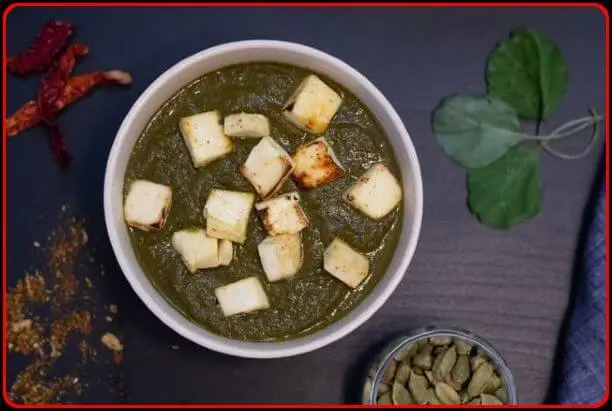
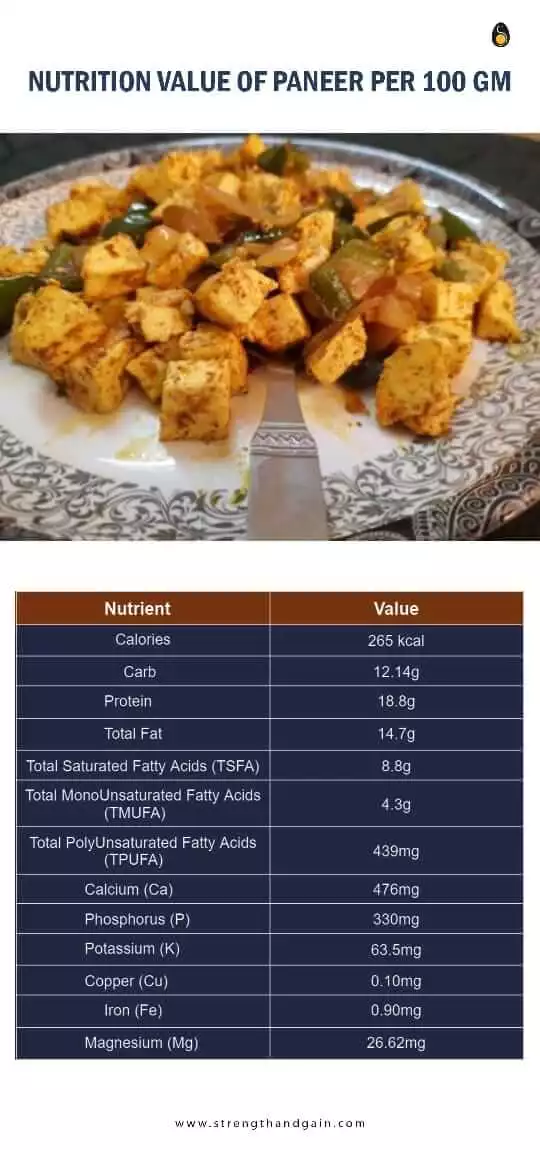
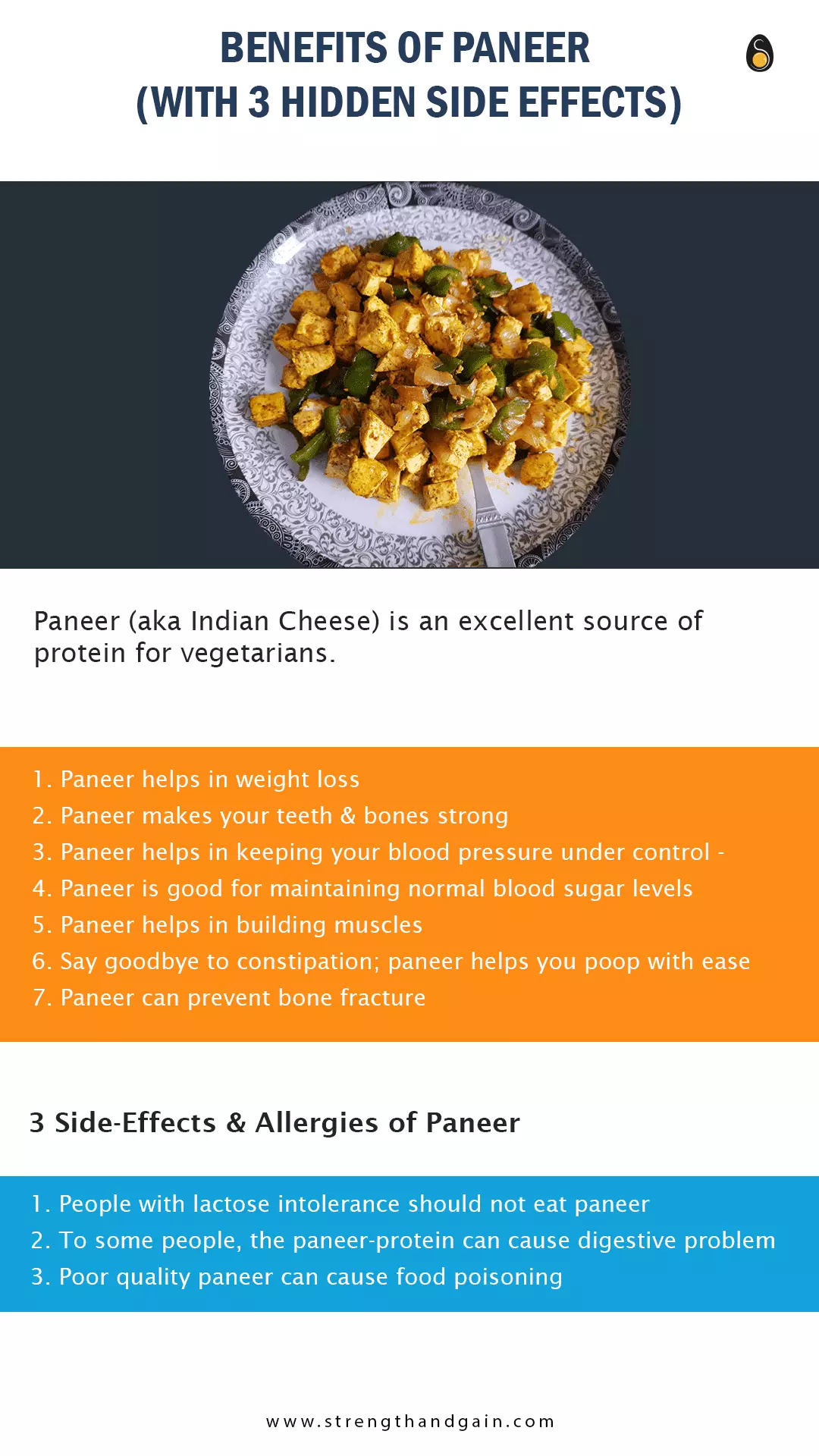

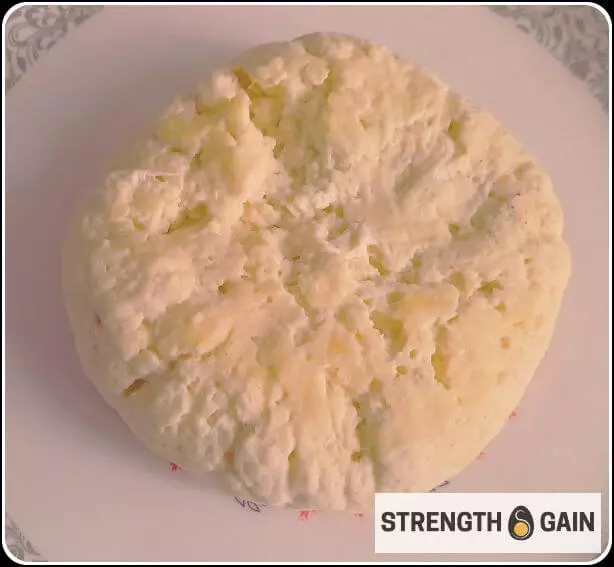
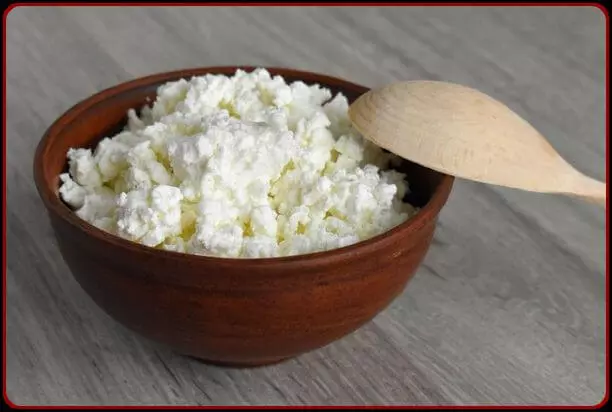
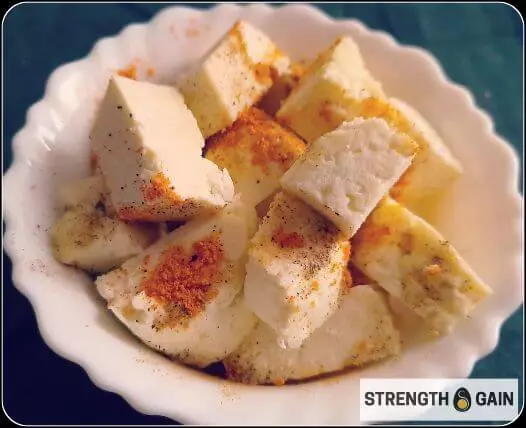
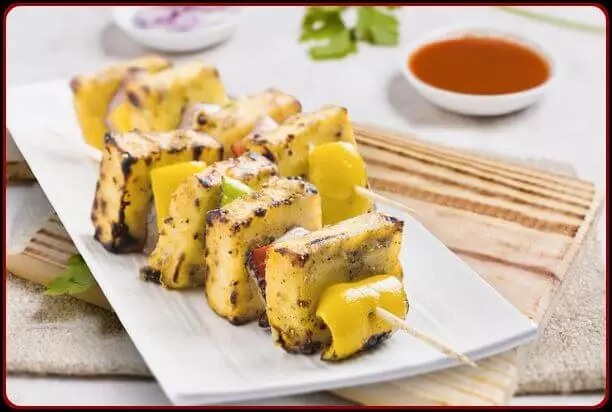
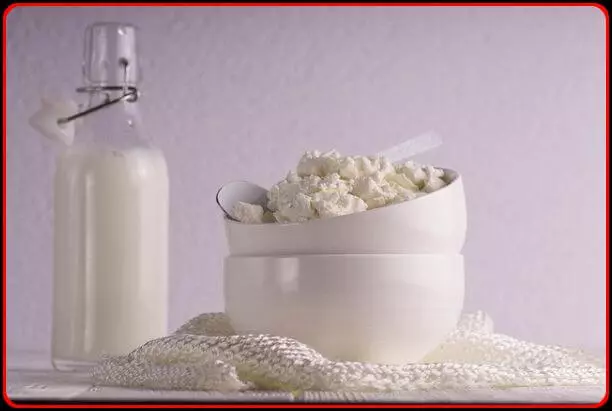
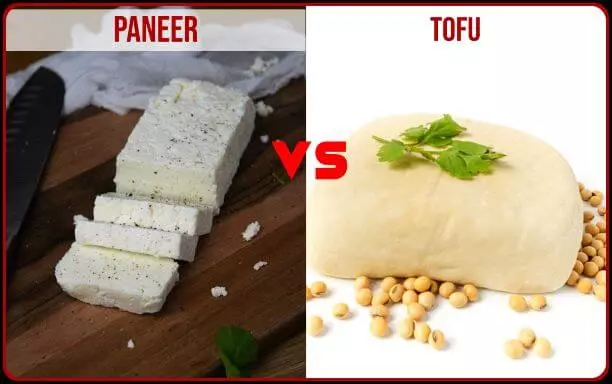
Leave a Reply